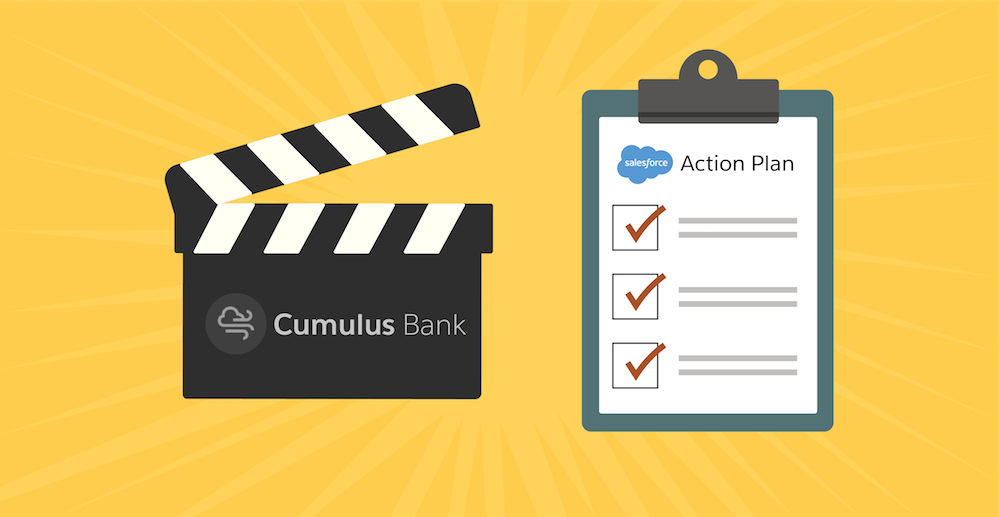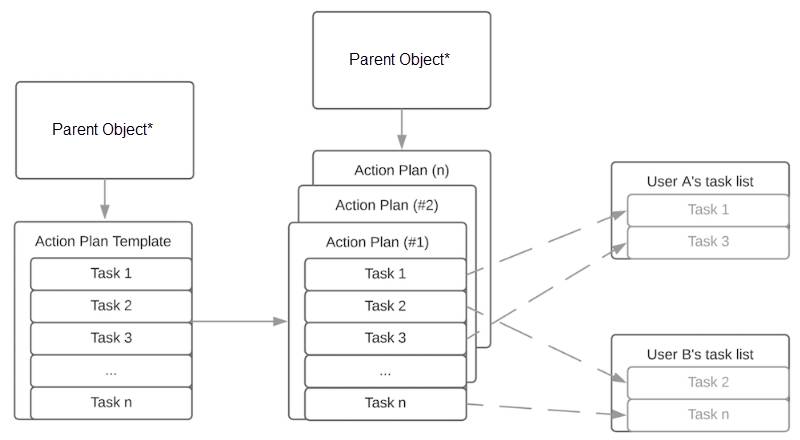Learn About Action Plans
Learning Objectives
After completing this module, you’ll be able to:
- Explain what Financial Services Cloud action plans are.
- List some benefits of using action plans.
- Explain the difference between action plan templates and action plans.
Introduction
If you’ve already earned one of the badges in the Inspire Customer Loyalty with Financial Services Cloud trail, you probably remember the team at Cumulus Cloud Bank. Let’s get reacquainted.
Ryan Dobson is a part-time admin, full-time wealth manager and financial advisor, and all-round superhero. Ryan works hard to understand his clients’ financial needs and goals and always goes the extra mile to help them plan their finances and secure their future. This is what makes Ryan such an asset to Cumulus.
Of course, Ryan can’t do this all alone. He is ably assisted by Srilakshmi Maajid, who recently joined the team as a client associate. Her job is to assist financial advisors like Ryan in planning, organization, and scheduling so they can focus on what’s important: helping clients succeed. Srilakshmi’s passionate about what she does and is constantly looking for opportunities to improve processes.
Finally, we can’t forget our all-star admin, Matt, who’s been working tirelessly to help Cumulus stay abreast of the latest industry trends in customer service and technology.
Superheroes Are People, Too
In fact, as Cumulus Cloud Bank strives to be a modern financial institution, there’s more than enough work to go around for everyone at the bank. While that’s usually no problem for our team, lately a few routine tasks have slipped through the cracks.
This has Ryan concerned. As a veteran financial advisor, he has a view of everything that goes on within the Wealth Management division of Cumulus Bank. He understands the ebb and flow of processes and tasks and how these need to work in concert so that the team captures and meets customers' needs in a timely manner.
Top of mind, he wants to make sure that the periodic financial plan review meetings with high-net-worth clients continue to go smoothly. There’s a fair amount of planning and prep work that happens before each one.
- Sending meeting invites well in advance
- Collecting the client’s financial documentation
- Reviewing the documentation
While these tasks are simple, with so many other priorities, Ryan’s afraid that someone can drop the ball, or miss a task or two. These tasks need to be done, done on time, and someone has to do it.
Meet Action Plans
Ryan recently heard Matt talk about a feature called Action Plans in Financial Services Cloud, and he’s curious to see if it can help solve his team’s task management woes. He asks Matt for more details.

Action Plans allow you to capture repeatable tasks and then automate the task sequences—improving collaboration and productivity. Using action plans, a team can automatically assign task owners and deadlines for specific client engagements. These can include Ryan’s financial plan meetings, account openings, loan approvals, and claims processing.
Action plans also make it easy to create reports and dashboards, so you can monitor progress and ensure compliance.
Action Plan Templates Vs. Action Plans
When you work with action plans, you first create action plan templates. So what's the difference between an action plan template and an action plan?
In an action plan template, you capture the repeatable tasks involved in a specific type of engagement, for example, financial plan review meetings with clients. For such engagements, wealth managers need to set up a meeting in advance, collect financial documentation, and review the documentation. You set up the action plan template once, and update it as your understanding of the repeatable tasks refines over time.
An action plan, on the other hand, is a run-time instance of the template that allows you to automate the sequence of the tasks you defined in the template. You generate an action plan from the template for each engagement, such as Ryan’s next financial plan review meeting with one of his most important clients, Kiara Shah.
This works the same way a meeting minutes template works in Microsoft Word. You define the structure and placeholder content in the template once, and create new instances of the template in a Word doc after every weekly team meeting.
Supported Salesforce Objects
You can create an action plan template (and therefore action plans as well) for various objects, depending on your Salesforce configuration and available licenses. Target objects for action plan templates include:
- Account
- Assets and Liabilities
- Business Milestone
- Campaign
- Card
- Contact
- Contract
- Financial Account
- Financial Deal
- Financial Goal
- Financial Holding
- Individual Application
- Insurance Policy
- Insurance Policy Coverage
- Lead
- Opportunity
- Person Life Event
- Residential Loan Application
What’s Inside an Action Plan
The types of items that can be included in an action plan template and its generated action plans include the following or a combination of both:
-
Document Checklist Item
Action Plans let you define repeatable tasks and sequences, and then automate task assignment and tracking. Often those tasks involve collecting and reviewing supporting documents needed for processes like loan origination or claim management. By including document checklist items in action plan templates, you can standardize and automate document tracking and approval steps for these processes.
Document tracking streamlines borrower engagement by allowing borrowers, loan officers, and mortgage underwriters to upload and review supporting documents that are required for a mortgage application.
For more information on this feature, check out the Trailhead module on mortgages in the Resources section.
-
Task
Tasks are a trusty old Salesforce feature. With tasks, you can keep your to-do list in Salesforce and stay right on top of your deals and accounts. Easily relate every task to records for leads, contacts, campaigns, contracts, and other information that you need. Salesforce gives you different tools to maximize productivity—quick ways to create and update tasks, prefiltered task lists, and task notification options.
Find out more about tasks in the Resources section.
Mechanics of Action Plan Templates and Action Plans
In an action plan template, assign each task or other item to a person, a role, a queue, or the action plan creator. When creating templates with the UI, the plan creator becomes the plan owner. When creating templates using the API, you can designate a plan owner different from the plan creator.
When you create an action plan from a template for a specific target record:
- Items that have no assigned user are assigned to the user who creates the action plan.
- Items assigned to a role shared by two or more users are assigned to the user who creates the action plan.
- Item deadlines are calculated using the start date and date offset defined in the action plan template. However, the plan creator can choose whether the date calculation is based on calendar or working days.
When an action plan starts, users see the tasks assigned to them through the standard Salesforce task lists and views. Users record task status information using the standard interfaces for tasks or other items, or the Action Plans details view. Target records, such as accounts or contacts, also show lists of related action plans.

Ryan’s excited by the possibilities. Follow along in the next units as he works with the team to set up the feature so all wealth managers at the bank can use action plans for recurring work. With action plans, they can assign tasks and set completion dates for those tasks, making sure nobody drops the ball and, most importantly, keeping clients happy.
What's Next
After learning about Action Plans in this unit, Ryan is excited by the possibilities. Follow along in the next unit as Matt sets up the feature so Ryan can make sure that nobody drops the ball. And they can keep clients happy. Let’s go!
